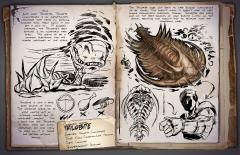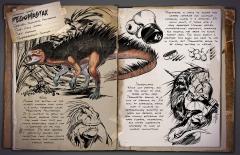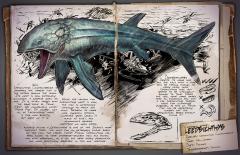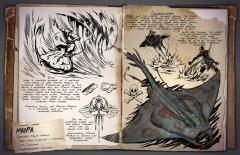Search the Community
Showing results for tags 'defensive'.
-
Have you ever wanted another monkey in ark but smart? Well the Homo habilis is the creature for you About I imagine this creature to be a more of a helper around the base and helper with fighting. This creature in real life is an ancestor of homosapiens (us) so it has the capabilities to wear armor and hold / use weapons this creature will be able to shoot crossbows and ordinary bows and tranq arrows as well as crafting things in it's inventory like tranq arrows and structures. The Homo habilis will shoot tranq arrows at creatures that you are trying to knock out and if possible. could feed babies over 1% maturity, I also imagine the Homo habilis to be almost like the sir-5rm8 but more for taming and raising as well as Defending your base against enemies. almost like having tameable tribemate Spawning These creatures would be found in the red woods in groups of 3 - 6 and the player would have to solo a Homo habilis from this group either by leading it away or killing the rest of the group Taming These creatures are intelligent and to tame one you'd have to give up your blueprints the higher tier blue prints the higher taming percentage increase (this is a passive tame) Usefulness As mentioned before they are basically a tamable tribemate being able to hold bows or cross bows with tranq darts and can help knock out creatures you are taming as well as helping feed babies over 1% maturity and finally it can craft structures, items and consumables in crafting stations or if the item your trying to craft is available in the player inventory the Homo habilis can craft it in its own inventory this will make crafting automated using a sir-5rm8 like system but instead of the recourse you the sir-5rm8 to craft you would put in the item you want the Homo habilis to craft e.g. putting metal hatchet instead of wood Outro I hope you can vote for my creature submission and thank you for reading
-
Dossier: The Glyptodon of the Arks are a close representation of their prehistoric counterpart although they seem to have adapted the size of modern day Armadillos. With the ability to curl up into a near impenetrable ball when startled the sheer force of this survival reaction shoots them a solid 5 feet into the air before they hit the ground rolling to safety! And if you think you could cut your way through these little fellas, THINK AGAIN!!! Their outer shell will dull even the sharpest of weaponry! Although, they seem quite shaken by blunt force hits! I've even seen survivors sneak up on these rodents in full ghillie then remove their helmets to send them into their ball mode and then use a club to smack them into nearby rocks and structures to knock them out! Info: Glyptodon is omnivorous and will feed on anything once knocked out and even tamed! They are skittish and will spook at the first sign of danger but if all else fails and they must attack be warry as they do carry the ever deadly mega rabies! This tame has great potential to bringing more use to the use of arks shields and even more use to using the MIGHTY CLUB!!! Tamed: Once you've tamed the Glyptodon they use their insane outer shell to the best of their abilities! Much like a shoulder pet they can join your adventures but prefer to ride rolled up in a shoulder sling pouch, napping the day away until their needed! Just pull them out the pouch and they can be used to throw at the enemies dazing them for a short time. Or you could simply roll them striking the feet of the opponent and crippling their movement. although, the Glyptodon wont attack and will quickly scurry back to their pouch to sleep of the torpor they gain from the interaction. But fear not! As if you are on the receiving end of the Glyptodon you can use a shield to block them causing severe torpidity! Oooorrr just try and slap it back at their owner with a wooden club? And with their rolling expertise do I hear the idea of a bowling Ally anyone???? When not riding along with the survivor the Glyptodon can be passively put to use at the base producing chitin through their scute that can be filed down periodically much like the Archelon's Algae.
-
- shoulderpet
- offensive
-
(and 5 more)
Tagged with:
-
From the album: Dossiers
Common Name: Trilobite Species: Trilobite Conchadurus Time: Early Cambrian-Late Permian Diet: Carnivore Temperament: Defensive Wild: Like most Trilobites, Trilobite Conchadurus is an opportunistic carnivore that feeds on anything smaller than itself which it can get a hold of. A sluggish creature, the Trilobite's best defense is its incredibly hard shell. This seems to be a common adaption for the slower creatures of the island. Trilobite is not a very good source of food. The creature seems to be made mostly out of internal organs and its defensive carapace. This is good for the Trilobite, as both river and ocean predators are less likely to prey on it if there are better options around. Domesticated: The Trilobite does not seem to have enough intelligence to be tamed. This doesn't mean it doesn't have its uses among resourceful survivors, though. Trilobites are easily one of the best sources of high quality chitin on the island, assuming one doesn't wish to venture into the dangerous caves. Known Information: Trilobite is not a very good source of food. The creature seems to be made mostly out of internal organs and its defensive Carapace. This is good for the Trilobite, as both river and ocean predators are less likely to prey on it if there are better options around. -
From the album: Dossiers
Common Name: Pegomastax Species: Pegomastax Fructarator Time: Early Jurassic Diet: Herbivore Temperament: Defensive Wild: Among the bottom of the island’s dinosaur food chain is a small herbivore called Pegomastax Fructarator. It is content to spend all day alone, gorging itself on far more food that you might reasonably expect for a creature of its tiny stature. It’s beak appears perfectly evolved for collecting food from plants while avoiding the indigestible fibrous strands. Pegomastax is likely to ignore any nearby creature and continue foraging, unless it is attacked. At which point, it turns into a very aggressive (though rather nonthreatening) opponent, shrieking and wooping far above it’s actual threat level. You would expect a creature this small and weak to live in flocks, but Pegomastax seems to be fairly solitary in nature. Domesticated: While not pretty, and far too small to ride, tribes often keep Pegomastax around as a kind of farming aid. It’s skill at scavenging means that it collects an extraordinary quantity of seeds and berries, while also handily gathering the rare flowers, mushrooms, and other ingredients necessary to cool up unusual conceptions.- 1 comment
-
- pegomastax
- defensive
- (and 8 more)
-
From the album: Dossiers
Common Name: Carbonemys Species: Carbonemys obibimus Time: Danian Diet: Herbivore Temperament: Defensive Wild: Carbonemys obibimus is one of the least aggressive creatures on the island. Were it not for the plethora of predators on the island, I'm certain it would spend its days basking in the sun, eating, or sleeping. Carbonemys leads a simple, solitary life. It seems to be one of the most peaceful animals I have yet encountered. With its slow walking speed, the only things that keep it safe are its surprisingly fast swim speed, and its incredibly thick shell. I would not be surprised to see a Carbonemys withdraw entirely into its shell and be completely safe from most predators. Domesticated: Carbonemys ' swift swim rate, fairly high strength, and lack of real threat makes it an ideal aquatic mount for many coastal survivors who shy away from violence. It can carry its rider to the ocean's resources at a fairly high speed, and are not particularly dangerous to tame.-
- carbonemys
- turtle
- (and 6 more)
-
From the album: Dossiers
Common Name: Leedsichthys Species: Leedsichthys Conviviumbrosia Time: Mid-Jurassic Diet: Piscivore Temperament: Defensive Wild: Leedsichthys Conviviumbrosia is probably the largest fish in the waters around the island. Its meant is also extremely succulent, a surprise given its size. It is often traded with the same value as Prime Meat, and colloquially called ‘Prime Fish’. Of course, not all of Leedsichthys’ meat is this high quality but most of it is! While the demand for Leedsichthys meat is high, the fish is notoriously difficult to track and hunt. Between its large size, powerful attacks, incredible speed (when it turns to flee), and humankind’s general ineptitude on open water, actually killing a Leedsichthys is one of the island’s more difficult tasks. The hunt for an extremely elusive breed of the fish, the fabled ‘Great Albino’ Leedsichthys has been known to drive otherwise-sensible men and women mad with obsession, as if all evil were visibly personified and made practically assailable in this one creature. Domesticated: Despite its large size, and the fact that it may well be strong enough to carry heavy loads, Leedsichthys does not appear to be intelligent enough to tame. Nevertheless, some large tribes keep an enormous pen with a few Leedsichthys trapped inside for cultivating purposes, as bits of prime fish can be repeatedly scraped off the gargantuan beast without killing it.-
- leedsichthys
- fish
- (and 7 more)
-
From the album: Dossiers
Common Name: Manta Species: Manta Mobula Time: Early Oligocene - Holocene Diet: Carnivore Temperament: Defensive Wild: Here is another example of a creature that seems to have evolved beyond its historical traits. Everything points to this being a saltwater ray, but Manta Mobula has developed the ability to swim into the island´s rivers and shallows, as well as through the open ocean. Perhaps there were originally two types of ray on the island before, but years of interbreeding combined their lineage. Normally docile, the Manta Mobula is a carnivore only in that it consumes Plankton. Its tail is incredibly sharp, and can pierce through thick hide and armor with ease. Fortunately, Manta Mobula is usually not aggressive, unless encouraged. Domesticated: While not the fastest swimmer around the island, Manta Mobula is the deadliest of small ocean mounts, and can be ridden bare-back. Tribes who value striking power over speed often keep large schools of Manta to ride. Its capability to briefly leap out of water provides it a showy tactic for avoiding combat as well. A quick jab through the heart onto an unsuspecting survivor can easily take them by surprise. Thusly, many tribes use it as an escort for their slower cargo-carrying swimmers.






